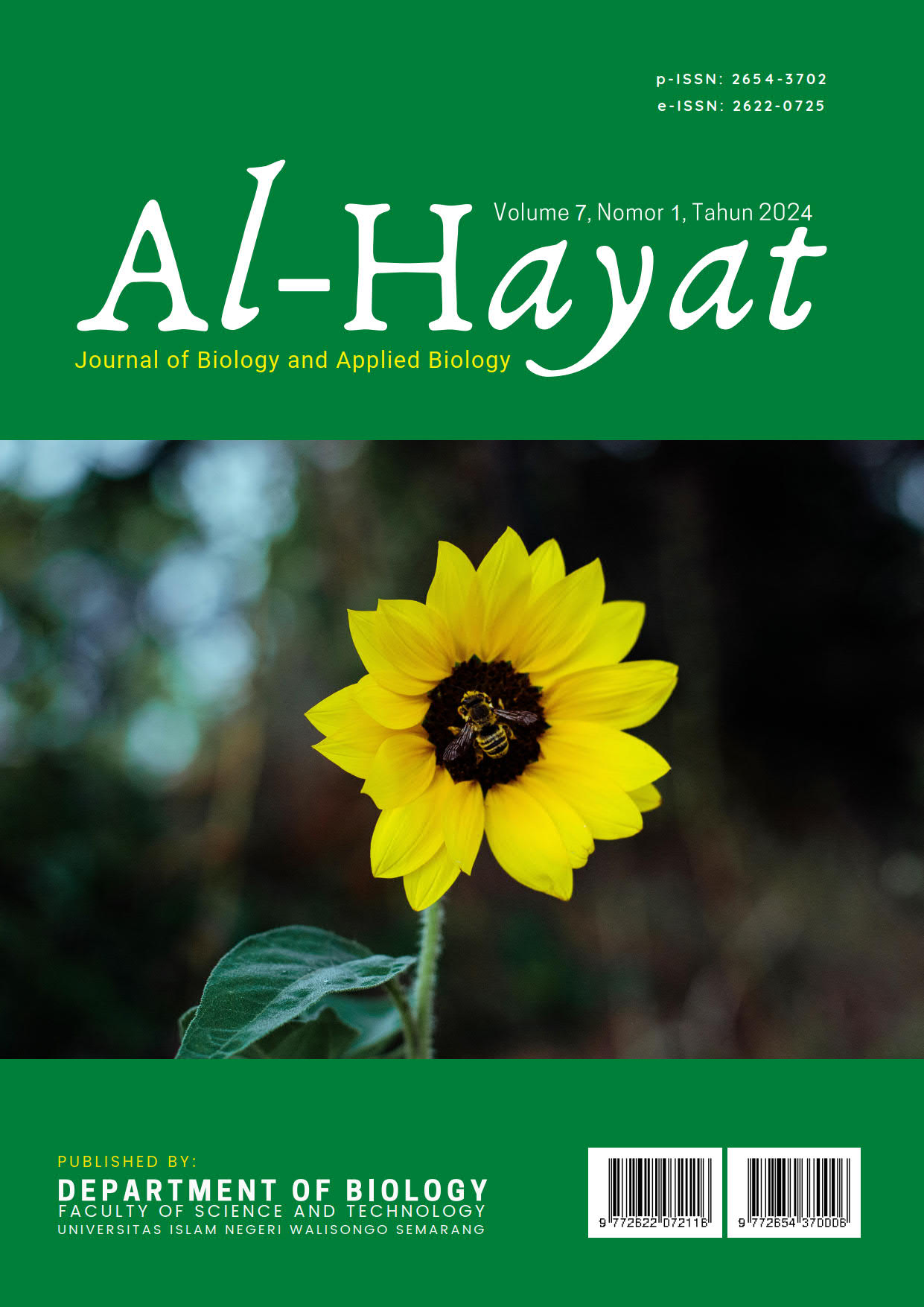The Inventory of ferns (Pteridophyta) in East Citorek, Lebak, Banten
Main Article Content
Abstract
East Citorek Village in Lebak Regency is a village that has a beautiful, cool and lush environment, and there are a lot of springs. These environmental conditions support the growth of various types of ferns. The people of East Citorek Village are not aware of varied types of ferns in their area. With the development plan of East Citorek Village as one of tourist destinations that is in the process of building facilities and accessibility, it is feared that it bears the potential to reduce and annihilate fern vegetation. The purpose of this study was to identify the types of fern (Pteridophyta) and determine the abiotic factors of ferns (Pteridophyta) at East Citorek Village, Lebak Regency. This research uses incorporates a qualitative approach using the cruise method, particularly by observing directly and exploring each place that is considered representative of the fern vegetation that becomes the concern of the study. Each type of fern plant was sampled to be identified and collected as a dry herbarium. The results of the study found that there were 19 species, 12 families, and 7 orders of fern in the area. The most common type of fern plant found comes from the Polypodiaceae family, while the type of fern that dominates the study site is the species of Dicranopteris linearis. The results of measuring environmental abiotic factors at East Citorek Village in Lebak Regency show that the results are still feasible for the survival of ferns within the average temperature measurement of 28◦C, air humidity of 76.3%, and soil pH of6.
Keywords: Identification, Fern, Pteridophyta, Herbarium
Downloads
Article Details

This work is licensed under a Creative Commons Attribution-ShareAlike 4.0 International License.
The copyright of the received article shall be assigned to the journal as the publisher of the journal. The intended copyright includes the right to publish the article in various forms (including reprints). The journal maintains the publishing rights to the published articles. Authors are allowed to use their articles for any legal purposes deemed necessary without written permission from the journal with an acknowledgment of initial publication to this journal.
The work under license Creative Commons Attribution-ShareAlike 4.0 International License.
References
Akbar, A., Indriani, A. I., Wulandari, R., Gifani, A. G., Salsabila, N., & Astuti, I. A. D. (2021). Pelatihan Water Purifier Dengan Metode Aerasi dan Filtrasi Menggunakan Saringan Pasir Cepat Sebagai Solusi Penjernihan Air Sumur di Desa Citorek Timur. Jurnal Pengabdian Kepada Masyarakat Radisi, 1(2), 92–99. https://doi.org/10.55266/PKMRADISI.V1I2.18
Apriyanti, N., Santri, D. J., & Madang, D. K. (2017). Identifikasi Tumbuhan Paku (Pteridophyta) dan Kekerabatannya di Kawasan Wisata Air Terjun Curup Tenang Bedegung Kecamatan Tanjung Agung Kabupaten Muara Enim. Jurnal Pembelajaran Biologi: Kajian Biologi Dan Pembelajarannya, 4(2), 113–125. https://doi.org/10.36706/FPBIO.V4I2.7117
Azizah, N. (2016). Karakter morfologi paku pisik naga (Pyrrosia piloselloides) pada pohon inang berbeda.
Dewanti, T., Nurchayati, N., & As’ari, H. (2020). Identifikasi Tumbuhan Paku (Pteridophyta) Di Kawasan Ijen Banyuwangi. Jurnal Biosense, 3(1), 46–55. https://doi.org/10.36526/BIOSENSE.V3I1.949
Efendi, W., & Iswahyudi, S. (2019). Keanekaragaman Tumbuhan Paku Di Jawa Timur (1st ed.). Graha Ilmu.
Hartini, S. (2011). Tumbuhan Paku Di Beberapa Kawasan Hutan Di Taman Nasional Kepulauan Togean Dan Upaya Konservasinya Di Kebun Raya Bogor. Berkalahayati, 7(1), 35–40.
Hidayah, N., Julita, T., Melvinasari, M. W., Dwiyanoto, G., Ristanto, R. H., & Sigit, D. V. (2021). Identifikasi Pterydophyta di Hutan Kota Jakarta, Indonesia. Proceeding of Biology Education, 4(1), 1–11. https://doi.org/10.21009/PBE.4-1.1
Janna, M., Dwi Riastuti, R., Pendidikan Biologi, S., Mipa, J., & PGRI Lubuklinggau, S. (2020). Keanekaragaman Jenis Tumbuhan Pteridophyta (Paku-Pakuan) Di Kawasan Curug Panjang Desa Durian Remuk Kabupaten Musi Rawas. Jurnal Biologi Dan Pembelajarannya (JB&P), 7(1), 19–22. https://doi.org/10.29407/JBP.V7I1.14801
Karliana, J. (2021). Identifikasi Tumbuhan Paku Terestrial Di Kawasan Hutan Lindung Pematang Kabuato Kecamatan Punduh Pedada Kabupaten Pesawaran.
Listiyanti, R., Indriyani, S., & Ilmiyah, N. (2022). Karakteristik Morfologi Jenis-Jenis Paku Epifit pada Tanaman Kelapa Sawit di Desa Tegalrejo. Al Kawnu : Science and Local Wisdom Journal, 2(1). https://doi.org/10.18592/AK.V1I3.7281
Manora, E. S. (2023). Keanekaragaman paku (pteridophyta)terestrial di kawasan mata air umbulan desa Ngenep Kecamatan Karangploso Kabupaten Malang.
Mariati, S., Prabowo, Y. D., Rahmanita, M., Habibie, F. H., & Mustika, A. (2023). Analysis of Tourism Village Management in Wewengkon Kasepuhan Customary Citorek, Lebak Regency, Banten Province-Indonesia. TRJ Tourism Research Journal, 7(2), 244. https://doi.org/10.30647/trj.v7i2.233
Mowata, J., Hendrik, A. C., & Daud, Y. (2020). Kelimpahan Tumbuhan Paku (Pteridophyta) di Hutan Desa Tanglapui, Kecamatan Alor Timur, Kabupaten Alor. Bio-Edu: Jurnal Pendidikan Biologi, 5(2), 75–86. https://doi.org/10.32938/jbe.v5i2.576
Riastuti, R. D., Sepriyaningsih, S., & Ernawati, D. (2018). Identifikasi Divisi Pteridophyta di Kawasan Danau Aur Kabupaten Musi Rawas. BIOEDUSAINS: Jurnal Pendidikan Biologi Dan Sains, 1(1), 52–70. https://doi.org/10.31539/bioedusains.v1i1.253
Saputro, R. W., & Utami, S. (2020). Keanekaragaman Tumbuhan Paku (Pteridophyta) di Kawasan Candi Gedong Songo Kabupaten Semarang. Bioma : Berkala Ilmiah Biologi, 22(1), 53–58. https://doi.org/10.14710/BIOMA.22.1.53-58
Sugiyono. (2014). Metode Penelitian Kuantitatif, Kualitatif, Dan R&D (21st editi). Alfabeta.
Tjitrosoepomo, G. (2014). Taksonomi Tumbuhan Schizophyta, Tahapollphyta, Bryophyta, Pteridophyta. UGM Press.
Ulfa, S. W. (2017). Botani Cryptogamae. Perdana Publishing.
Wijayanto, A., Suhadi, S., Saptasari, M., Pitaloka, D. A., & ... (2019). Dicranopteris linearis (Burm. F) Underw.: Catatan Baru Database Tumbuhan d Cagar Alam/Taman Wisata Alam Kawah Ijen, Indonesia. Jurnal Ilmu Hayat, 3(1), 38–44.
Yuni Imrotun Khasanah, 150207032. (2020). Analisis Vegetasi Tumbuhan Paku Di Kawasan Jeget Ayu Kecamatan Jagong Jeget Kabupaten Aceh Tengah Sebagai Referensi Praktikum Matakuliah Botani Tumbuhan Rendah.
Yunita, I., Nurma, N., Ibrahim, I., & Andalia, N. (2022). Identifikasi Jenis-Jenis Tumbuhan Paku (Pteridophyta) Yang Tumbuh Di Desa Uning Pune Kecamatan Putri Betung Kabupaten Gayo Lues. Jurnal Biology Education, 9(1), 52–68. https://doi.org/10.32672/jbe.v9i1.4519

